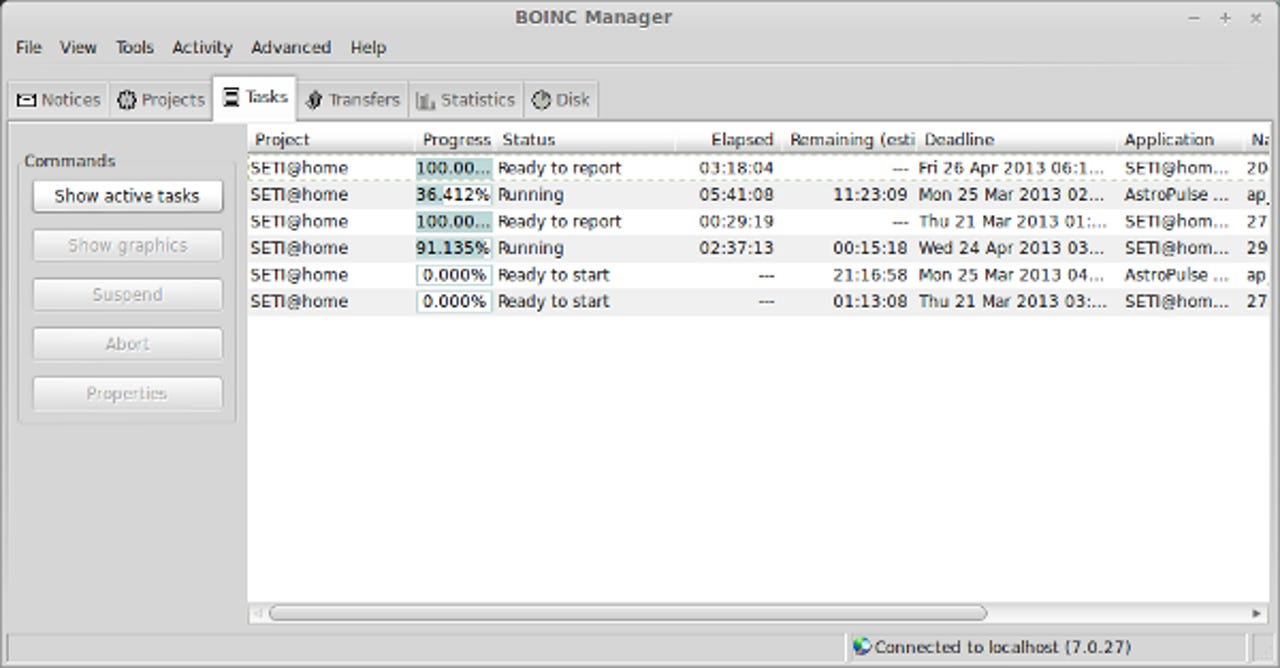Distributed computing for the greater good

What do you think your computer does most of the time? For most of us, most of the time, it just sits there idly spinning its wheels.
It doesn't have to be that way. There are many distributed computer programs, such as Seti@home, the search for alien life; Folding@home, protein research for understanding how many diseases work; and the just announced Quantum Cures project which seeks to find cures for "orphan" diseases. Most can put your PC to useful work while you're drinking coffee or asleep in your bed.

These programs use the power of up to hundreds of thousands of computers around the world to create distributed supercomputers. While no single distributed project is as fast as a Top500 supercomputer, they're still faster than the computers to which most researchers have access.
Distributed computing is as old as the hills. This technique started being used across the Internet for public distributed computing projects only in 1997 with distributed.net. This project, which continues to this day, is devoted largely to cracking high-end encryption protocols.
The most popular early distributed computing project, and certainly the most influential, is Seti@home. The purpose of this project, which has been running since 1999, is to see if there are signs of intelligent extraterrestrial life in the universe from radio astronomy's raw data.
While we still haven't heard from any ETs, Seti@home developers created the most popular, public-distributing computing software: Berkeley Open Infrastructure for Network Computing (BOINC). This open-source middleware program handles the distribution, processing, and retrieval of work-units. Each work-unit is a small part of a larger task.
When you're running a BOINC, or any other public distributing computing project, the program works on its projects in the background. BOINC clients are available for Linux, Mac OS X, Windows and almost all other operating systems.
At this time, there are just over 2.5-million BONIC users. Of these, 10% are active at any given moment. The total average floating point operations per second of all BONIC projects in late February 2013 was 8,723 TeraFLOPS. How fast is that? Summed up, that would make the global BONIC cluster the world's 4th fastest supercomputer. Now, that's fast. Of course, its throughput is far slower than any "real" supercomputer, but it gives you an idea of just how powerful distributed computing really is.
Today, there are about 50 BONIC projects. These include: Malaria Control, which tries to work out the best prevention methods for controlling this tropical disease; SIXTRACK, which runs particle acceleration simulations for CERN's Large Hadron Collider (LHC); and the Quake-Catcher Network, which is designed to use PCs, with the appropriate sensors, to monitor earthquakes around the world.
The newest of these projects, Quantum Cures, which is being done in conjunction with EURORDIS, a non-governmental patient-driven alliance of patient organizations representing 561 rare disease patient groups in 51 countries worldwide. Its purpose is to speed the discovery of small molecules for use in new medicines and vaccines the so-called “orphan and rare diseases.” These are ailments that traditionally do not receive the attention or research and development efforts of the world’s major pharmaceutical companies because their are not enough cases to make it profitable to fight them. These diseases include isolated spina bifida, cleft palates, Hodgkin’s lymphoma, and sleeping sickness.
“There is substantial interest in and reason to pursue development of treatment and cures for a wide range of diseases which have, up until now, not received the attention they deserve,” said Lawrence Husick, Quantum Cures' co-founder in a statement. “By enlisting the help and computer time from many people, we can begin to deliver the resources needed to find the answers, and improve the quality of life of millions, both today and in the future.”
TeraDiscoveries, the company that developed Inverse Design -- the computational technique used in the Quantum Cures effort -- is contributing its software, developed in partnership with Duke University and Microsoft, at cost.
The client needed to take part in Quantum Cures will be available by the end of June on a limited basis at the project's main site. You can sign up now to get on the “launch priority list” and be given preference in downloading the software. The project also claims that "people donating their computer time to be used for the research may be able to take a tax deduction for the time their machines are used."
Tax benefits or not, this, and most of the many other distributed computing projects, are doing good work using your idle computers. If you'd like to help with one or more of these projects, Wikipedia maintains a useful list of public distributed computing projects.
Related Stories: